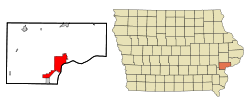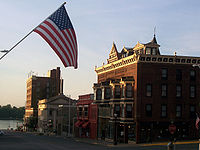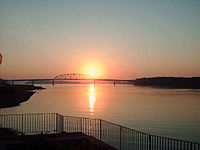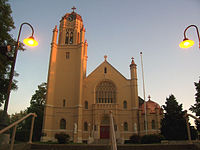- Muscatine, Iowa
-
Muscatine — City — Muscatine County Courthouse Location in the State of Iowa Coordinates: 41°25′26″N 91°3′22″W / 41.42389°N 91.05611°WCoordinates: 41°25′26″N 91°3′22″W / 41.42389°N 91.05611°W Country  United States
United StatesState  Iowa
IowaCounty Muscatine Incorporated 1839 Government – Mayor Dick O'Brien Area – City 17.9 sq mi (46.3 km2) – Land 16.8 sq mi (43.6 km2) – Water 1.1 sq mi (2.7 km2) Elevation 581 ft (177 m) Population (2010)[1] – City 22,886 – Rank 22nd in Iowa – Density 1,278.5/sq mi (493.6/km2) – Metro 54,741 Time zone CST (UTC-6) – Summer (DST) CDT (UTC-5) ZIP code 52761 Area code(s) Area code 563 FIPS code 19-55110 GNIS feature ID 0465186 Website http://www.muscatine.com/ Muscatine is a city in Muscatine County, Iowa, United States. The population was 22,886 in the 2010 census, an increase from 22,697 in the 2000 census.[1] It is the county seat of Muscatine County[2]. The name Muscatine is unusual in that it is not used by any other city in the United States.[3]
Muscatine is the principal city of the Muscatine Micropolitan Statistical Area (2000 census population 53,905), which includes all of Muscatine and Louisa counties.
Contents
History
The European-American city of Muscatine began as a trading post founded by representatives of Colonel George Davenport in 1833. Muscatine was incorporated as Bloomington in 1839; the name was changed to reduce mail delivery confusion, as there were several Bloomingtons in the Midwest. Before that, Muscatine had also been known as "Casey's Woodpile".
The name Muscatine is believed by some to have been named after the Mascouten native American tribe.[3] The Algonquian-speaking Mascoutin were driven out of Michigan in approx 1642 by French and Natives, and they were believed to have been absorbed into the Meskwaki (Fox) and Sac tribes by the early 18th century.[4]:66 In 1819 Muscatine Island was known as Mascoutin Island. An alternative theory is that the name is derived from a Siouan-language term meaning "Fire Island". Major William Williams, who was visiting when the town changed its name in 1849, wrote in his journal: "Muscatine in English is Fire Island," in his list of the meanings of Sioux Indian names.[5]
Williams also wrote a brief description of the settlement:
“ Bloomington is a fine town, one of the most important points in the state. Its situation on one of the great bends of the Mississippi has great commercial advantages; [it] is the seat of justice of Muscatine County. Contains about 2000 inhabitants, is the natural depository for a vast amount of trade from the surrounding country, has many neat residences and several spacious brick mercantile establishments- a large steam mill, one smaller one, two printing establishments, 6 churches, 4 physicians, 8 lawyers, an neat court house and jail, Masonic lodge, etc.... This town is very prettily situated, in part on a level on the river for two streets back, when the ground rises and the remaining street is elevated in benches, the whole standing in a rise enclosed by a range of high bluffs which runs around it in a semicircular form, forming beautiful sites for residences. From the bluff there is a beautiful view of the town below and of the Mississippi for miles up and down. All steam boats land here, passing up and down. ” —Maj. William Williams
From the 1840s to the Civil War, Muscatine had Iowa's largest black community, consisting of fugitive slaves from the South and free blacks who had migrated from the eastern states. One of the most prominent community leaders was Alexander Clark Sr., a Pennsylvania native, barber and eventually a wealthy timber salesman and real estate speculator. He was among the founders of the local AME Church, assisted fugitive slaves, and petitioned the state government to overturn racist laws before the war. In 1863, Clark helped organize Iowa's black regiment, the 60th United States Colored Infantry (originally known as the 1st Iowa Infantry, African Descent), though an injury prevented him from serving.
In 1868, he successfully desegregated Iowa's public schools by suing the Muscatine board after his daughter Susan was turned away from her neighborhood school. Eleven years later, his son Alexander Jr. became the first black graduate of the University of Iowa College of Law, and its first black graduate from any department. Clark Sr. went to the college and became its second black graduate five years later, despite being 58 years old, saying that he wanted to serve “as an example to young men of his own race.” Clark rose to prominence in the Republican Party, serving as a delegate to various state and national conventions.
In 1890, Clark was appointed ambassador to Liberia by President Benjamin Harrison. He was one of four Muscatine residents to be appointed as a diplomatic envoy between 1855 and 1900, a remarkable feat for a town of such small size: George Van Horne was consul at Marseilles, France during the 1860s; Samuel McNutt served at Maracaibo, Venezuela in 1890; and Frank W. Mahin represented his country in Reichenberg, Austria in 1900.
Less than a year after arriving in Liberia, Clark died of fever. His body was returned to the US, where he was buried in Muscatine's Greenwood Cemetery. In 1975 the city moved his former house about 200 feet, to make room for a low-income apartment complex for senior citizens; the latter was named in his honor. The University of Iowa's chapter of the Black Law Students Association (BLSA) is named for the Clarks, as a testament to the accomplishments of father and son, and their places in the history of civil rights in Iowa.
The writer Sam Clemens (better known by his pen-name Mark Twain) lived in the city briefly during the summer of 1855 while working at the local newspaper, the Muscatine Journal, which was partly owned by his brother, Orion Clemens. He noted some recollections of Muscatine in his book Life on the Mississippi:
“ And I remember Muscatine—still more pleasantly—for its summer sunsets. I have never seen any, on either side of the ocean, that equaled them. They used the broad smooth river as a canvas, and painted on it every imaginable dream of color, from the mottled daintinesses and delicacies of the opal, all the way up, through cumulative intensities, to blinding purple and crimson conflagrations which were enchanting to the eye, but sharply tried it at the same time. All the Upper Mississippi region has these extraordinary sunsets as a familiar spectacle. It is the true Sunset Land: I am sure no other country can show so good a right to the name. The sunrises are also said to be exceedingly fine. I do not know. ” —Mark Twain
In 1884 J.F. Boepple, a German immigrant, founded a pearl button company. He produced buttons that looked like pearls by machine-punching them out of clam shells harvested from the Mississippi River. Muscatine's slogan, "Pearl of the Mississippi," refers to the days when pearl button manufacturing by the McKee Button Company was a significant economic contributor. In 1915, Weber & Sons Button Co., Inc. was the world's largest producer of fancy freshwater pearl buttons. From that time forward, Muscatine was known as "The Pearl Button Capital of the World". Weber is still manufacturing today, and celebrated its 100-year anniversary in 2004. Muscatine is nearly as well known as the "Watermelon Capital of the World".[6]
Muscatine was hit by an EF3 (Enhanced Fujita Scale 3) tornado on June 1, 2007, which destroyed or damaged wide areas of the city.[7]
Geography
According to the United States Census Bureau, the city has a total area of 17.9 square miles (46.3 km²), of which, 16.8 square miles (43.6 km²) of it is land and 1.0 square miles (2.7 km²) of it (5.87%) is water.

Sunrise over the Mississippi River Muscatine is primarily located on a series of bluffs and hills at a major west-south bend in the Mississippi River. The river-bend gives the city roughly 260 degrees of riverfront. The "highland" area of the town is divided into three ridge-like hills by Papoose Creek and Madd Creek, each of which flow individually into the Mississippi in downtown Muscatine. The city's main roads follow these ridges and valleys in a spider-web-like fashion. Several large working-class neighborhoods and industrial sectors have been built on what is called "Muscatine Island". This flat, sandy expanse was largely underwater when a portion of the Mississippi River followed the course of the present-day Muscatine Slough. It is unclear when the river changed course. The hills, river, and island are all integral to the diversity of Muscatine's economy and housing sector. As the city's urbanized area develops, the areas of highest elevation in the "High Prairie" crescent (between the Cedar and Mississippi Rivers) are increasingly re-appropriated from agricultural land to suburban housing.
Positioned some 25 miles (30 minutes) from the Quad Cities, 38 miles (52 minutes) from Iowa City, IA and some 68 miles (75 minutes) from Cedar Rapids, IA, Muscatine is the smallest link in a non-contiguous populated area which surpassed 800,000 residents in the decade following the 2000 Census. The key feature of this region is that although the populated areas are non-contiguous, a high percentage of residents commute between the cities for work, particularly those in professional fields. Despite this relatively high regional density, Muscatine has maintained a small town-small city feel, remaining a family friendly community, while deferring to the larger cities around it for many commercial services and educational, medical and cultural advancements.
Demographics
Muscatine
Historical PopulationsCensus Pop. %± 1870 6,718 — 1880 8,295 23.5% 1890 11,454 38.1% 1900 14,073 22.9% 1910 16,178 15.0% 1920 16,068 −0.7% 1930 16,778 4.4% 1940 18,286 9.0% 1950 19,041 4.1% 1960 19,813 4.1% 1970 22,405 13.1% 1980 23,467 4.7% 1990 22,881 −2.5% 2000 22,697 −0.8% 2010 22,886 0.8% Iowa Data Center [1] As of the census[8] of 2000, there were 22,697 people, 8,923 households, and 6,040 families residing in the city. The population density was 1,348.1 people per square mile (520.4/km²). There were 9,375 housing units at an average density of 556.9 per square mile (214.9/km²). The racial makeup of the city was 90.40% White, 1.08% African American, 0.37% Native American, 0.65% Asian, 0.03% Pacific Islander, 6.04% from other races, and 1.44% from two or more races. Hispanic or Latino of any race were 12.30% of the population.
There were 8,923 households out of which 33.4% had children under the age of 18 living with them, 52.7% were married couples living together, 11.0% had a female householder with no husband present, and 32.3% were non-families. 27.4% of all households were made up of individuals and 11.4% had someone living alone who was 65 years of age or older. The average household size was 2.49 and the average family size was 3.04.
In the city the population was spread out with 26.4% under the age of 18, 9.2% from 18 to 24, 28.6% from 25 to 44, 21.9% from 45 to 64, and 14.0% who were 65 years of age or older. The median age was 36 years. For every 100 females there were 94.7 males. For every 100 females age 18 and over, there were 90.2 males.
The median income for a household in the city was $38,122, and the median income for a family was $45,366. Males had a median income of $36,440 versus $23,953 for females. The per capita income for the city was $19,483. About 8.0% of families and 10.9% of the population were below the poverty line, including 13.2% of those under age 18 and 9.6% of those age 65 or over.
Economy
Companies in Muscatine include HNI Corporation, Bridgestone Bandag, Heinz, Carver Pump, Monsanto, Muscatine Foods Corporation, Musco and The Stanley Group.
Headquartered in Muscatine, The HON Company designs and manufactures office furniture including chairs, filing cabinets, workstations, tables, desks and education furniture.[9]
Points of interest
- Riverfront (which includes the Pearl City Station, Riverview Center, and "Mississippi Harvest" sculpture by Erik Blome)
- Mark Twain Scenic Overlook
- Kent Stein Park (which includes historic Tom Bruner Field)
- Weed Park and Aquatic Center
- Muscatine Community Stadium and the nearby Pearl City Rugby field
- Muscatine History and Industry Center
- Muscatine Art Center, including Musser Mansion and the Stanley Gallery
- Weed Mansion, Alexander G. Clark House, and many other historic homes dating back to the mid-19th century
- Two historic districts (Downtown and West Hill) are listed on the National Register of Historic Places
- Discovery Park and Learning Center
- W. Joseph Fuller House
- St. Mathias Catholic
- Sinnett Octagon House
- Pearl Button Museum
Government
Muscatine is governed by a seven-member city council headed by a mayor. The current mayor, Richard O'Brien, was first elected in 1993.[10] The council consists of one representative from each of the city's five wards, plus two at-large representatives. The current city council members are, Philip Fitzgerald (Ward 1), Mark LeRette (Ward 2), Jerry Lange (Ward 3), Bob Bynum (Ward 4), Dyann Roby (Ward 5), Scott Natvig (At large), and Osama Shihadeh (At large).[11]
Education
Muscatine Community School District is home to the Muscatine Muskies. Muscatine Schools cover Muscatine, Fairport, and Montpelier, as well as rural areas of Letts, Fruitland, and Blue Grass.
Muscatine is home to Muscatine Community College and the MCC Cardinals.
Media
Print
The Muscatine Journal newspaper circulates daily throughout the Muscatine area except on Sundays.[12] It is commonly believed to have existed since 1840.
Radio
Prairie Radio Communications, a midwestern broadcasting company, has two radio stations in Muscatine. KWPC-AM, which has been a long part of the city's history, and KMCS-FM, which has only been in the community since 1995. Cumulus Broadcasting's KBEA-FM broadcasts from a tower near 10 Miles north of Muscatine.
Transportation


Norbert F. Beckey Bridge over the Mississippi River with LED lights.
The bridge is the only span over the Mississippi River with this type of lighting.Muscatine is located along two designated routes of Iowa's "Commercial-Industrial Network", U.S. Highway 61 and Iowa Highway 92. Highway 61 serves as a major agricultural-industry route to the south from Burlington, IA to Muscatine, where it becomes a heavy-industrial and major commuter route to the northeast between Muscatine and Davenport, IA. In conjunction with Iowa 92, which provides access to the Avenue of the Saints (U.S. 218/IA 27) to the west and the lightly populated western Illinois via the Norbert Beckey Bridge to the east, Highway 61 serves as a shortcut for traffic from northeastern Missouri and southeastern Iowa en route to the Quad Cities, Chicago, and points beyond. Several regional highway improvement projects are in the works to further establish and capitalize on this trade-route. Additionally, Muscatine is connected to Interstate 80 to the north by fifteen miles of Iowa Highway 38. Iowa Highway 22 also connects with U.S. 218/IA 27 to the west, and Davenport to the east.
Notable people
- Lee Allen, medical illustrator
- Norman G. Baker (1882–1958) Invented the Calliaphone, Established the Know the Naked Truth (KTNT) a border blaster radio station [13][14]
- Ben Barkema, Tight End for the Cleveland Browns. Barkema graduated in 2004 from Muscatine High School. He then played for the Iowa State Cyclones.
- Terry Beatty, artist who has worked as a penciler and inker in the comic book industry.
- Ellis Parker Butler, author
- Alexander Clark, an African American diplomat who served as the United States Ambassador to Liberia.
- C. Maxwell Stanley, engineer, entrepreneur, philanthropist, founder of Stanley Consultants, co-founder of HON Industries, and delegate to the United Nations.
- Max Allan Collins, author of screenplay of the movie Mommy, which was filmed in Muscatine's Wood Creek neighborhood in 1995. Also author of the graphic novel Road to Perdition, which became a screenplay and was filmed in 2002, starring Tom Hanks and Jude Law.
- Al Gould, Major League Baseball player for the Cleveland Indians
- Scot Halpin, fan who filled in for drums with the Who when Keith Moon collapsed during a performance at the Cow Palace in San Francisco in 1973.
- Jim Yong Kim (1959– ) President of Dartmouth College, Co-founder and Executive Director of Partners In Health [15]
- Ralph P. Lowe, fourth Governor of Iowa
- Emmett Lynn, actor
- James Bradley Orman, former Governor of Colorado
- Dame Margherita Roberti, internationally famous opera singer who spent much of her childhood in Muscatine, including graduating from Muscatine High School. In 1970 she was knighted by the Italian government.
- Phil Vischer, founder of the Christian series VeggieTales
Sister cities
Muscatine has nine sister cities, as designated by Sister Cities International:
 Crespo, Argentina (emeritus)
Crespo, Argentina (emeritus) Drohobych, Ukraine
Drohobych, Ukraine Ichikawadaimon, Japan
Ichikawadaimon, Japan Kislovodsk, Russia
Kislovodsk, Russia Łomża, Poland
Łomża, Poland Ludwigslust, Germany
Ludwigslust, Germany Paraná, Argentina (emeritus)
Paraná, Argentina (emeritus) Paysandú, Uruguay (emeritus)
Paysandú, Uruguay (emeritus) Ramallah, Palestine
Ramallah, Palestine
References
- ^ a b c "Data from the 2010 Census". State Data Center of Iowa. http://www.iowadatacenter.org/archive/2011/02/feb10. Retrieved March 26, 2011.
- ^ "Find a County". National Association of Counties. http://www.naco.org/Counties/Pages/FindACounty.aspx. Retrieved 2011-06-07.
- ^ a b "The Prosperous Industrial History of Muscatine" Greater Muscatine Chamber of Commerce & Industry, 2004. Retrieved 2008-05-09.
- ^ Irving Berdine Richman, John Brown Among the Quakers: And Other Sketches, Historical Department of Iowa, 1894
- ^ a b Williams, William (1920). "Major William Williams' Journal of a Trip to Iowa in 1849". Annals of Iowa 12 (4): 249–250, with minor spelling and punctuation changes.
- ^ History
- ^ "Terrible touchdown in Muscatine" Muscatine Journal, 2007-06-01. Accessed 2007-06-01.
- ^ "American FactFinder". United States Census Bureau. http://factfinder.census.gov. Retrieved 2008-01-31.
- ^ http://www.smithgroup.com/index.aspx?id=1421§ion=37
- ^ Muscatine, IA - Official Website
- ^ Muscatine, IA - Official Website - City Council
- ^ http://www.inanews.com/apps/displaypapers.php?mod=About&action=City&city=Muscatine
- ^ "Dr Norman G Baker". Find a Grave. April 25, 2005. http://www.findagrave.com/cgi-bin/fg.cgi?page=gr&GRid=10852107. Retrieved March 17, 2011.
- ^ Norman Baker / Tangley
- ^ Lewin, Tamar (March 2, 2009). "Dartmouth Selects Its New President From Harvard". The New York Times. http://www.nytimes.com/2009/03/03/education/03dartmouth.html. Retrieved March 4, 2011.
External links
- Official website of the City of Muscatine
- Muscatine Chamber of Commerce
- City Data Comprehensive Statistical Data and more about Muscatine, Iowa
Municipalities and communities of Muscatine County, Iowa County seat: MuscatineCities Atalissa | Blue Grass‡ | Conesville | Durant‡ | Fruitland | Muscatine | Nichols | Stockton | Walcott‡ | West Liberty | Wilton
Unincorporated
communitiesArdon | Cranston | Fairport | Hinkeyville | Montpelier | Moscow | Petersburg
Footnotes ‡This populated place also has portions in an adjacent county or counties
Categories:- Cities in Iowa
- Muscatine micropolitan area
- Populated places in Muscatine County, Iowa
- County seats in Iowa
Wikimedia Foundation. 2010.








